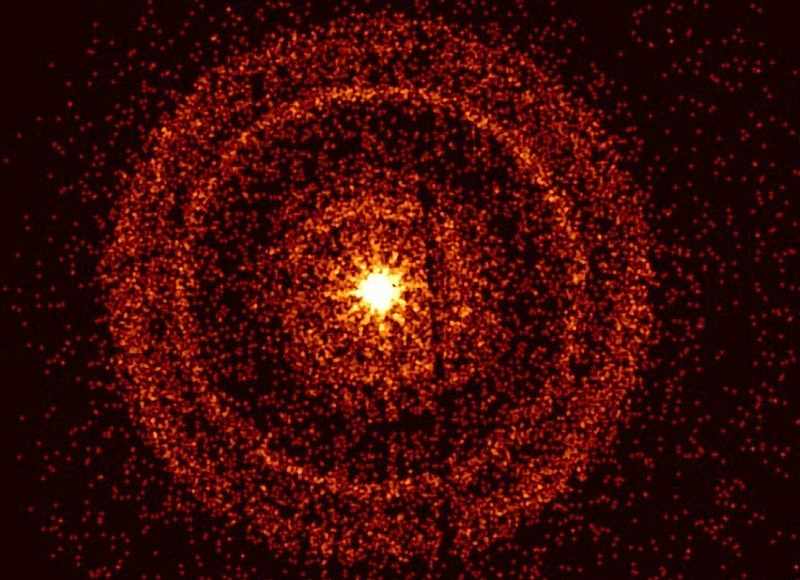
The Swift X-Ray Telescope capturing the afterglow of GRB 221009A about an hour after it was first detected is seen in this photo provided by NASA on Oct. 14.
18:03 JST, November 10, 2022
WASHINGTON (AFP-Jiji) — Astronomers have observed the brightest flash of light ever seen, from an event that occurred 2.4 billion light years from Earth and was likely triggered by the formation of a black hole.
The burst of gamma-rays — the most intense form of electromagnetic radiation — was first detected by orbiting telescopes on Oct. 9, and its afterglow is still being watched by scientists around the world.
Astrophysicist Brendan O’Connor told AFP that gamma-ray bursts that last hundreds of seconds, as occurred on Oct. 9, are thought to be caused by dying massive stars, over 30 times bigger than our sun.
The star explodes in a supernova, collapses into a black hole, then matter forms in a disk around the black hole, falls inside, and is spewed out in a jet of energy that travels at 99.99% the speed of light.
The flash released photons carrying a record 18 teraelectronvolts of energy — that’s 18 with 12 zeros behind it — and it has impacted long-wave radio communications in Earth’s ionosphere.
“It’s really breaking records, both in the amount of photons, and the energy of the photons that are reaching us,” said O’Connor, who used infrared instruments on the Gemini South telescope in Chile to take fresh observations on Oct. 14.
“Something this bright, this nearby, is really a once-in-a-century event,” he added.
Gamma-ray research first began in the 1960s when U.S. satellites designed to detect whether the Soviet Union was detonating bombs in space ending up finding such bursts originating from outside the Milky Way.
“Gamma-ray bursts in general release the same amount of energy that our sun produces over its entire lifetime in the span of a few seconds — and this event is the brightest gamma-ray burst,” said O’Connor.
This gamma-ray burst, known as GRB 221009A, was first spotted by telescopes including NASA’s Fermi Gamma-ray Space Telescope, Neil Gehrels Swift Observatory, and Wind spacecraft on the morning of Oct. 9.
It originated from the direction of the constellation Sagitta, and traveled an estimated 1.9 billion years to reach Earth — less than the current distance of its starting point, because the universe is expanding.
Observing the event now is like watching a 1.9 billion-year-old recording of those events unfold before us, giving astronomers a rare opportunity to glean new insights into things like black hole formation.
“That’s what makes this sort of science so addictive — you get this adrenaline rush when these things happen,” said O’Connor, who is affiliated with the University of Maryland and George Washington University.
Supernova explosions are also predicted to be responsible for producing heavy elements — such as gold, platinum, uranium — and astronomers will also be on the hunt for their signatures.
Astrophysicists have written in the past that the sheer power of gamma-ray bursts could cause extinction level events here on Earth.
But O’Connor pointed out that because the jets of energy are very tightly focused, and aren’t likely to arise in our galaxy, this scenario is not something we should worry much about.
"Science & Nature" POPULAR ARTICLE
-

Mass Oyster Die-Offs Confirmed in Japan’s Seto Inland Sea; High Water Temperature Cited as Primary Cause
-

Genome Study Reveals Milestone in History of Cat Domestication
-

Big Leap in Quest to Get to Bottom of Climate Ice Mystery
-

Security Camera Footage Vulnerable to Outside Access; Investigation Finds 3,000 Pieces Exposed Online
-

Paws on Parade: Nairobi’s Dogs Dazzle at ‘Pawchella’
JN ACCESS RANKING
-

Keidanren Chairman Yoshinobu Tsutsui Visits Kashiwazaki-Kariwa Nuclear Power Plant; Inspects New Emergency Safety System
-

Imports of Rare Earths from China Facing Delays, May Be Caused by Deterioration of Japan-China Relations
-

Japan Exports Rise in October as Slump in U.S. Sales Eases
-

Japan Pulls out of Vietnam Nuclear Project, Complicating Hanoi’s Power Plans
-

Govt Aims to Expand NISA Program Lineup, Abolish Age Restriction























